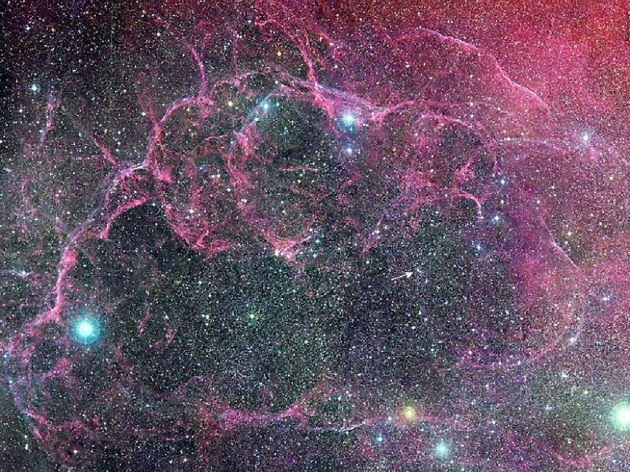By Annelies Rhemrev
November 7, 2012
Vela Supernova Remnant
Image Credit: NASA/The Hubble Heritage Team (STScI/AURA)
Click here for a larger image.
The Vela Supernova Remnant (R762-0019) is a huge supernova remnant around 100 light-years across, located about 800 light-years away in the southern constellation Vela, what makes it one of the closest known supernova remnants to Earth. The stellar explosion occurred approximately 11,000-12,300 years ago. This was direct observational proof that supernovae can form neutron stars.
The Vela supernova remnant includes the Pencil Nebula (NGC 2736) — and also overlaps the Puppis Supernova Remnant, which is four times more distant. Both the Puppis and Vela remnants are among the largest and brightest features in the X-ray sky.
A supernova occurs when a star explodes in the final phase of its life. The exploding star can become billions of times as bright as the Sun before gradually fading from view. At its maximum brightness, the exploded star may outshine an entire galaxy.
After some supernova explosions, there remains a small, dense star composed mainly of neutrons. Such a star is called a neutron star. Rapidly rotating, highly magnetized neutron stars are called pulsars. (After other supernova explosions, a black hole may be left behind.) The explosion throws a large, roughly spherical cloud of dust and hot gas into space surrounding the neutron star (or black hole). When this slams into the existing interstellar medium, it heats up so much it glows in X-rays
The star in Vela brightened by about 100 million times to rival the Moon as the brightest object in the night sky. Near the centre of the expanding nebula is the Vela pulsar (PSR J0835-4510), a faint, rapidly-spinning neutron star only a few kilometres in diameter, the remnant of the star that exploded. This tiny, massive object spins about 11 times a second.
The Vela supernova explosion was roughly spherical. Non-uniformity of the interstellar medium causes Vela’s appearance to be irregular. The outer layers of the star crashed into the interstellar medium, driving a shock wave that is still visible today. The above image captures much of that filamentary and gigantic shock in visible light.
This close-up image was taken with the Hubble Space Telescope. The little arrow shows the place of the Vela pulsar.
See more images on Anne’s Astronomy News



